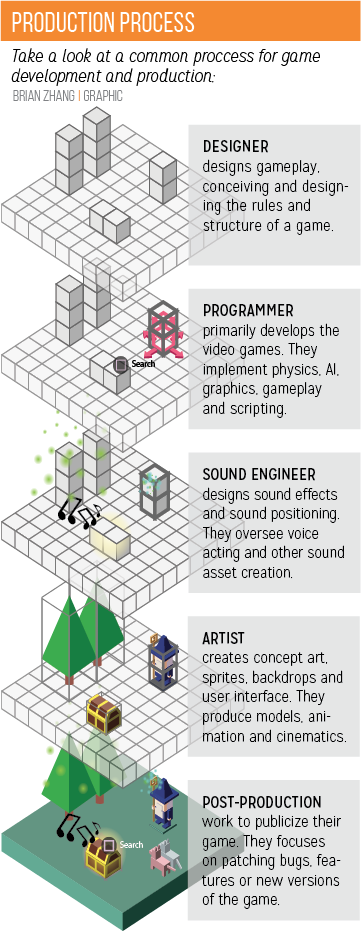 Video games are a common pastime for many CHS students. Games such as “Overwatch” and “Fortnite Battle Royale” are becoming increasingly popular among the student body. But for some students like senior Matthew Konkoly, he’s more interested to see how games work and he’s started designing them from scratch.
Video games are a common pastime for many CHS students. Games such as “Overwatch” and “Fortnite Battle Royale” are becoming increasingly popular among the student body. But for some students like senior Matthew Konkoly, he’s more interested to see how games work and he’s started designing them from scratch.
Konkoly developed the game “Impulse: Space Combat,” a first-person spaceship action game, currently available on the online marketplace Steam.
“I had it up on (itch.io) and on there, (the game) got over 5,000 free downloads…as for the actual paid version of the game (on Steam it had), I think 600 purchases all over the world,” Konkoly said.
Konkoly said he has created numerous games for over four years.
“I’ve been interested in video games all my life and I got interested in making games when I was in eighth grade with a program called Scratch,” Konkoly said. “After that, (my enjoyment of games) sort of just evolved and eventually I worked my way up to actual programming and 3D modeling.”
Konkoly is not the only student who works with game design. Junior Andrew Gostomelsky also pursues this hobby in his free time, and he mainly focuses on experimenting with smaller game features.
“One of the things I’ve done is taking models and basically blowing them up so they explode into hundreds of different pieces and spread out everywhere,” Gostomelsky said. “The pieces are actually part of the model; they are not some random small piece.”
Konkoly also said that basic features are a good place to start.
“You work with really simplified objects, like a basic cube, and you can use those to make the gameplay systems,” Konkoly said. “After that, I use a program called ‘Blender’ where I make the (3D models) and then move it into ‘Substance,’ where I can add the textures and materials. After that, it all goes back into the Unity Engine.”
Theresa Kane, Computer Programming II: Simulation And Game Development teacher, said her course can be a great place for students to learn the core essentials of programming and game development via Python, a simpler language, before moving to the advanced programs like Unity.
“I like Python because with Unity and Blender you are given a lot of stuff for free, whereas with Python you ultimately create your own gaming classes and gaming objects,” Kane said.
However, Kane said she urges students to use these skills to help the community. As such, she said Computer Programming II students are given the opportunity to produce games for Riley Children’s Hospital.
“I want to give (Riley Children’s Hospital) games that look really professional and that the patients there can use,” she said. “The doctors try to rehab younger patients who…are using physical therapy. So, a lot of the games use hand-eye coordination and really appeal to the patients. Xbox and Playstation games aren’t accessible for them because of the speed and the requirements for playing them. We want the (patients) to be able to use their fingers and use their hands to make selections.”
Gostomelsky said although game development can be daunting, the challenges are worth overcoming.
Gostomelsky said, “It’s tough. It’s not easy, it’s not nice, it’s time consuming, and a lot of times you are going to want to quit. You have to push through to actually be able to finish a project because it happens to everyone.”































![What happened to theater etiquette? [opinion]](https://hilite.org/wp-content/uploads/2025/04/Entertainment-Perspective-Cover-1200x471.jpg)














































![Review: “The Immortal Soul Salvage Yard:” A criminally underrated poetry collection [MUSE]](https://hilite.org/wp-content/uploads/2025/03/71cju6TvqmL._AC_UF10001000_QL80_.jpg)
![Review: "Dog Man" is Unapologetically Chaotic [MUSE]](https://hilite.org/wp-content/uploads/2025/03/dogman-1200x700.jpg)
![Review: "Ne Zha 2": The WeChat family reunion I didn’t know I needed [MUSE]](https://hilite.org/wp-content/uploads/2025/03/unnamed-4.png)
![Review in Print: Maripaz Villar brings a delightfully unique style to the world of WEBTOON [MUSE]](https://hilite.org/wp-content/uploads/2023/12/maripazcover-1200x960.jpg)
![Review: “The Sword of Kaigen” is a masterpiece [MUSE]](https://hilite.org/wp-content/uploads/2023/11/Screenshot-2023-11-26-201051.png)
![Review: Gateron Oil Kings, great linear switches, okay price [MUSE]](https://hilite.org/wp-content/uploads/2023/11/Screenshot-2023-11-26-200553.png)
![Review: “A Haunting in Venice” is a significant improvement from other Agatha Christie adaptations [MUSE]](https://hilite.org/wp-content/uploads/2023/11/e7ee2938a6d422669771bce6d8088521.jpg)
![Review: A Thanksgiving story from elementary school, still just as interesting [MUSE]](https://hilite.org/wp-content/uploads/2023/11/Screenshot-2023-11-26-195514-987x1200.png)
![Review: "When I Fly Towards You", cute, uplifting youth drama [MUSE]](https://hilite.org/wp-content/uploads/2023/09/When-I-Fly-Towards-You-Chinese-drama.png)
![Postcards from Muse: Hawaii Travel Diary [MUSE]](https://hilite.org/wp-content/uploads/2023/09/My-project-1-1200x1200.jpg)
![Review: "Ladybug & Cat Noir: The Movie," departure from original show [MUSE]](https://hilite.org/wp-content/uploads/2023/09/Ladybug__Cat_Noir_-_The_Movie_poster.jpg)
![Review in Print: "Hidden Love" is the cute, uplifting drama everyone needs [MUSE]](https://hilite.org/wp-content/uploads/2023/09/hiddenlovecover-e1693597208225-1030x1200.png)
![Review in Print: "Heartstopper" is the heartwarming queer romance we all need [MUSE]](https://hilite.org/wp-content/uploads/2023/08/museheartstoppercover-1200x654.png)


